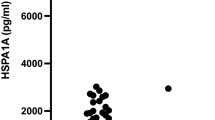Abstract
This paper describes a prospective immunohistochemical analysis of 27 kDa heat shock protein (HSP27) in 361 patients with primary breast cancer in relation to disease-free survival (DFS) and survival from first relapse (SR). Oestradiol (ER) and progesterone (PR) receptors were also quantitated and related to the HSP27 data. While ER positively predicted a good outcome for both DFS and SR, HSP27 positivity predicted a prolonged SR but short DFS. The association between HSP27 and DFS only attained statistical significance in node-negative patients. Subgroup analysis reinforced the complementary relationship of HSP27 and ER for SR and opposing influences for DFS. In both node-negative and node-positive women, ER+ HSP27- patients had a longer DFS than ER- HSP27+ counterparts. There was no relationship between HSP27 and overall survival. HSP27 staining was highly correlated with ER but not PR, patient age, tumour size or menstrual status. There was a marginal correlation (P = 0.04) with histological grade with well-differentiated tumours having the highest HSP27. Cox multivariate regression analysis of the contribution of HSP27 in the presence of data on ER, PR, stage, nodal status and histological grade indicated that HSP27 was not of independent prognostic importance for DFS or overall survival and was only of borderline significance for OS (P < 0.07). However, in the absence of ER and PR data, HSP27 staining is an effective way of getting the same prognostic information. HSP27 staining appears to correlate with different biological features in early and advanced breast, high HSP27 being linked with short DFS in node-negative patients but with prolonged survival from first recurrence.
This is a preview of subscription content, access via your institution
Access options
Subscribe to this journal
Receive 24 print issues and online access
$259.00 per year
only $10.79 per issue
Buy this article
- Purchase on Springer Link
- Instant access to full article PDF
Prices may be subject to local taxes which are calculated during checkout
Similar content being viewed by others
Author information
Authors and Affiliations
Rights and permissions
About this article
Cite this article
Love, S., King, R. A 27 kDa heat shock protein that has anomalous prognostic powers in early and advanced breast cancer. Br J Cancer 69, 743–748 (1994). https://doi.org/10.1038/bjc.1994.140
Issue Date:
DOI: https://doi.org/10.1038/bjc.1994.140
This article is cited by
-
Cluster analyses of the TCGA and a TMA dataset using the coexpression of HSP27 and CRYAB improves alignment with clinical-pathological parameters of breast cancer and suggests different epichaperome influences for each sHSP
Cell Stress and Chaperones (2022)
-
Significance of unphosphorylated and phosphorylated heat shock protein 27 as a prognostic biomarker in pancreatic ductal adenocarcinoma
Journal of Cancer Research and Clinical Oncology (2020)
-
Characterization of protein marker expression, tumorigenicity, and doxorubicin chemoresistance in two new canine mammary tumor cell lines
BMC Veterinary Research (2014)
-
Heat shock protein 27: a potential biomarker of peritoneal metastasis in epithelial ovarian cancer?
Tumor Biology (2014)
-
The role of heat shock proteins in bladder cancer
Nature Reviews Urology (2013)



